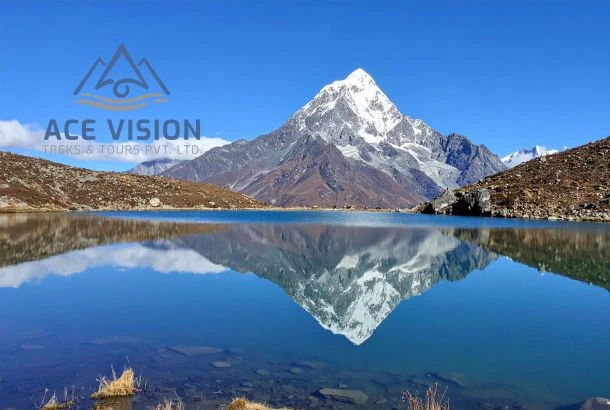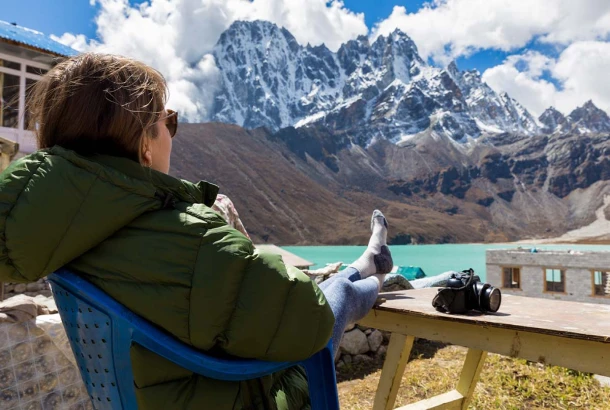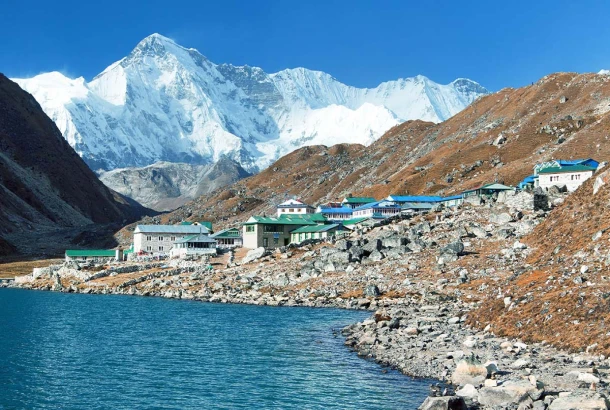The challenges of the Everest Base Camp trek
The Everest Base Camp trek is hard in different ways for different people. Even though this trek is recommended to beginner trekkers, the journey can be quite arduous for some of them. Your fitness, understanding of the region and its limitations, knowledge about high altitude, supporting team, preparation, etc, determine how difficult the Everest Base Camp trek will be for you.
This trek does not require any technical expertise. It is a long hiking adventure with a rising altitude every day. Basic fitness is needed for the Everest Base Camp trek, as you will be trekking for 6 hours a day at a minimum. It is better not to rush while ascending. Have ample acclimatization days in your itinerary and maintain daily elevation gain under 500 meters as well.
Terrain
The Everest Base Camp trekking route is rugged and steep in some places. The trail starts through lush rhododendron and magnolia forests and ascends to boulder fields and glacier moraines. Until you reach Everest Base Camp and Kala Patthar, it is mostly uphill walking with a few descents. You will follow uneven cliff sides as well and walk along glaciers.
Distance and daily walking Hours
The Everest Base Camp trek distance is 130 kilometers. Each side is 65 kilometers. You trekking 9 to 11 kilometers daily on average. Some days include long distances up to 15 kilometers. Likewise, the daily walking hours during the Everest Base Camp trekking is 6 hours on average.
The longest days are when you trek from "Namche Bazaar to Tengboche, Dingboche to Lobuche, Lobuche to Everest Base Camp via Gorak Shep, Gorak Shep to Kala Patthar to Pheriche, Phercihe to Namche Bazaar, and Namche Bazaar to Lukla".
High Altitude
The high altitude is one of the most significant Everest Base Camp trek challenges. This is what adds more difficulty to trekking in the upper part of the trail. Everest base camp trek starts from Lukla at 2,845 meters (9,334 ft). From Kathmandu (1,400 m/4,600 ft), you will gain 1,455 meters (4,774 ft) in just 30 minutes of flight.
It is a drastic elevation change and may trigger altitude sickness, so trekkers descend to Phakding village 2,610 meters (8,563 ft) to spend the night. From Lukla to Everest Base Camp (5,364 m/17,600 ft), altitude gain2,519 meters (8,264 ft) in total. Kala Patthar (5,545 m/18,192 ft) is the highest point of the trek.
As you see, the variation in elevation is quite drastic in a short period and exposes you to decreasing levels of oxygen as you ascend, which makes trekking more demanding. You will get tired quickly and could suffer from altitude sickness if you are not careful. Altitude sickness is a common thing during the EBC trek.
Most of the Everest Base Camp trek packages include two acclimatization days in the itinerary, which helps to adjust to elevation and avoid altitude sickness. It's better if you do not compromise on acclimatization days during Everest Base Camp trekking. Be careful of the symptoms and inform your guide if you feel discomfort during the trek.
Unpredictable weather
The Khumbu region, also known as the Everest region, is famous for its unpredictable and challenging weather conditions. Even during the peak trekking seasons, the clear skies can suddenly give way to rain, strong winds, or snowfall. This unpredictability requires a proper Everest Base Camp trek plan and backup.
Likewise, as you gain elevation, you can feel the daytime warm, whereas mornings and nights are relatively cold. You have to prepare for all kinds of weather and temperatures. Spring (March to May) and autumn (September to November) are the two primary seasons for this trek.
Winter (December to February) and summer/monsoon (June to August) are off time. The offseason has the worst weather conditions. You cannot predict anything. The Lukla flight is mostly delayed or canceled too. Therefore, very few trekkers trek to Everest base camp in winter and summer/monsoon.

Limited tourist Facilities
The Everest region is famous, especially the Everest Base Camp trail, but this doesn't mean it is not a remote area. Compared to other trekking routes, the Everest Base Camp trail does have better accommodations and facilities, but at the end of the day, the region also has many limitations.
The trail offers lodges and tea houses accommodation. They are simple, with limited services like beds, shared washrooms, and communal dining areas. There is no heating system, so you have to carry a sleeping bag and every essential toiletry, including toilet paper, hand soap, etc.
Charging, WiFi, hot showers, etc, all require an additional few bucks, which is not covered in the Everest Base Camp package cost unless it is a luxury package. The limited tourist facilities along the Everest Base Camp trail demand you to be flexible and adjust.
Compared to Lukla and Namche Bazaar, the upper part of the trail has fewer services. And everything will cost you additional money.
Khumbu Cough
Khumbu Cough is a term used to describe a persistent and often irritating cough that some trekkers experience during the Everest Base Camp trek and other high-altitude treks in the Khumbu region of Nepal. As you ascend to higher altitudes, the air becomes increasingly dry and thin. At elevations above 13,000 feet (4,000 meters), the humidity levels drop significantly.
This dryness can irritate the respiratory passages and lead to coughing. Moreover, the cold air further dries out the respiratory tract, making it more susceptible to irritation. Individuals with pre-existing respiratory conditions, such as asthma or bronchitis, are more prone to experiencing Khumbu Cough.
Trekking during the peak season
The Everest Base Camp trek is very famous. In the peak trekking seasons, you'll sharing the trails with a significant number of other trekkers, climbers, and support staff. This result in congested paths and, at times, slow progress, especially in narrow sections.
Likewise, tea houses and lodges along the trail get fully booked, and securing a room can be challenging. Sometimes trekkers, especially solo trekkers, have to share a room or sleep in common areas when accommodations are scarce.
Trekking during the off-season
Winter treks to Everest Base Camp bring freezing temperatures, especially at higher altitudes. Sub-zero temperatures can make hiking and overnight stays in lodges exceptionally cold and uncomfortable. Likewise, snowfall is common during winter months, and trails are covered with snow and ice.
This increases the risk of slips and falls, making certain sections of the trek more treacherous. Likewise, summer/monsoon makes the trail equally challenging with heavy rainfall, bugs, slippery trails, and landslide risks. The views get obstructed in both seasons. Many lodges along the trail are closed during the offseason due to the extreme weather conditions and lack of trekkers.

Everest Base Camp Trek Route Difficulty Overview
Below is our popular 14-day Everest Base Camp trek itinerary. We have made a daily route overview for you. You can learn how much you are going to ascend or descend each day, along with the difficulty level of trekking from one particular village to another.
Day 01: Arrival in Kathmandu (1,400 m/4,600 ft)
Day 02: Flight from Kathmandu to Lukla airport (2,846 m/9,337 ft) and trek to Phakding (2,610 m/8,563 ft)
- Trek distance: 6.2 km/3.8 miles
- Duration: 30 minutes flight & 4 hours trek
- Elevation difference: 1,445 m/4,740 ft ascend & 196 m/643 ft descend
- Difficulty: Easy
Day 03: Trek from Phakding to Namche Bazaar (3,440 m/11,290 ft)
- Trek distance: 7.4 km/4.6 miles
- Duration: 6 hours
- Elevation difference: 789 m/2,589 ft ascend
- Difficulty: Strenuous
Day 04: Acclimatization in Namche Bazaar: hike to Syangboche Airstrip (3,748 m/12,297 ft) and Everest View Hotel (3,962 m/13,000 ft)
- Duration: 4-5 hours
- Elevation difference: 350 m/1,148 ft ascend
- Difficulty: Medium
Day 05: Trek from Namche Bazaar to Tengboche Monastery (3,860 m/12,660 ft)
- Trek distance: 9.2 km/5.7 miles
- Duration: 5 hours
- Elevation difference: 430 m/1,410 ft ascend
- Difficulty: Easy/medium
Day 06: Trek from Tengboche to Dingboche (4,410 m/14,470 ft)
- Trek distance: 12 km/7.45 miles
- Duration: 5 hours
- Elevation difference: 490 m/1,608 ft ascend
- Difficulty: Hard
Day 07: Acclimatization in Dingboche; hike to Nagarjuna Hill (5,100 m/16,732 ft)
- Duration: 4-5 hours
- Elevation difference: 740 m/2,427 ft ascend
- Difficulty: Hard
Day 08: Trek from Dingboche to Lobuche (4,940 m/16,210 ft)
- Trek distance: 8.5 km/5.2 miles
- Duration: 5-6 hours
- Elevation difference: 580 m/1,903 ft ascend
- Difficulty: Strenuous
Day 09: Trek from Lobuche to Everest Base Camp (5,364 m/17,598 ft) via Gorak Shep (5,164 m/16,942 ft) and back to Gorak Shep for a night's stay
- Trek distance: 15 km/9.32 miles
- Duration: 8 hours
- Elevation difference: 424 m/1,391 ft ascend & 200 m/656 ft descend
- Difficulty: Strenuous
Day 10: Hike to Kala Patthar (5,545 m/18,192 ft) early in the morning and trek down to Pheriche (4,371 m/14,340 ft)
- Trek distance: 9.6 km/6 miles
- Duration: 6 hours
- Elevation difference: 381 m/1,250 ft ascend & 793 m/2,601 ft descend
- Difficulty: Strenuous
Day 11: Trek from Pheriche to Namche Bazaar (3,440 m/11,290 ft)
- Trek distance: 17.7 km/10.9 miles
- Duration: 6-7 hours
- Elevation difference: 931 m/3,054 ft descend
- Difficulty: Strenuous
Day 12: Trek Namche Bazaar to Lukla (2,846 m/9,337 ft) via Phakding (2,610 m/8,563 ft)
- Trek distance: 16.7 km/10 miles
- Duration: 6-7 hours
- Elevation difference: 595 m/1,952 descend
- Difficulty: Strenuous
Day 13: Morning flight back to Kathmandu (1,400 m/4,600 ft) from Lukla airport & farewell dinner in the late evening
- Duration: 35 minutes flight
- Elevation difference: 1,446 m/4,744 ft descend
Day 14: Final departure

Physical and Mental Challenges of the Everest Base Camp Trek
The Everest Base Camp trek is a demanding journey that presents trekkers with a combination of physical and mental challenges. High altitude, long trekking days, and steep ascents and descents, including rocky trails, put a strain on the body.
Not only that, you will be dealing with a bad network, no connection to the outside world, limited modern facilities, etc. Both physical and mental challenges are much more than you think during the Everest Base Camp trekking.
Below are the physical and mental challenges you'll encounter on this iconic trek:
- High altitude
- Long hours of walking
- Strenuous ascents and descents
- Cold weather
- Unpredictable weather
- Physical fatigue
- Limited resources
- Poor network connection
- Dealing with discomfort
- Fear and anxiety
Proper preparation and training
The Everest Base Camp trek does not demand superhuman fitness, but a good level of physical preparedness is essential. Trekkers should be able to walk 5-7 hours a day on varied terrain while carrying a backpack. Cardiovascular fitness, muscular endurance, and strength are crucial for the trek. You do not need to hire a personal trainer or leave your daily work to prepare for the trek. Regular exercises and a fitness training routine will be enough.
You can do the following things to train for Everest Base Camp trekking:
- Cardiovascular training: Do regular aerobic exercises, such as cycling, running, hiking, swimming, etc. These activities will help you improve your cardiovascular fitness and build stamina and endurance.
- Strength training: You have to make your legs and core strong, as these parts of the body are heavily engaged during the EBC trek. You can go to the gym or do these home strength training- lunges, squats, step-ups, planks, etc.
- Hiking practice: If possible, go on hikes as much as you can. Walk for long hours and carry a backpack with a 5 kg load on you to mimic the trekking conditions.

Guided vs solo Everest Base Camp trekking
Trekking with a guide or solo, both options have their own set of pros and cons.
Guided Everest Base Camp Trekking:
One of the most significant advantages of guided trekking is logistics support. You do not have to worry about booking accommodation, meals, permits, transportation, etc. The trekking company like us will do all the leg work for you. Trekking with a guide, you will have a native by your side who will make the journey seamless and immersive for you.
Trekking Guide provide valuable insights into the culture and environment. Likewise, guides are trained to recognize and respond to altitude-related illnesses and other potential risks. Reliable trek guide ensure your trekking is safe and enjoyable. The guide help you interact with local communities, helping you gain a deeper understanding of the Sherpa culture and traditions.
Solo Everest Base Camp Trekking:
Solo trekking provides you the freedom to set your own pace, choose your itinerary, and make spontaneous changes along the way. However, solo trekkers may lack insights into the local culture, history, and geography, which can enrich the experience. Similarly, communication barriers with villagers can be challenging without knowledge of the Nepali language.
Likewise, solo trekkers are responsible for their safety and may not have the expertise to recognize and respond to altitude-related illnesses or other hazards. Planning, and organizing permits, accommodations, and transportation can be time-consuming and challenging.

Choose the right Tour Trekking Company
Picking the right 'Tour trekking company' is important. Talk to the company, ask about their experience, values, and goals, and see how much they contribute to the local economy and sustainable travel. Trekking to Everest Base Camp with the right company will not only make the journey safe and hassle-free for you but also help the locals along the trail and the environment.
We, Ace Vision Treks & Tours, are one of the old ex-guided trekking companies in Nepal with a huge customer satisfaction rate. Our experienced guides and staff are experts in the field. With many years of experience in the Everest region, they know the trails, the culture, and the best ways to ensure your safety and enjoyment.
Safety is our top priority. Our guides are trained in first aid and altitude sickness prevention. They closely monitor your health throughout the trek. Likewise, with us, you don't have to worry about permits, accommodations, transportation, or meal arrangements. We take care of all the logistics so you enjoy the journey.
We offer flexible itineraries to suit your preferences and schedules. Whether you want a classic 12-day trek or a longer, more leisurely journey, we customize your trek to meet your needs. Our trips are eco-friendly, and we work closely with the locals along the trail.
We make sure our EBC trek does not harm the fragile ecosystem of the Everest region. And to mention, we have the best Everest Base Camp trek cost in the market with top-notch service.

Safety Precautions for EBC Trek
- Start your trek with a good level of physical fitness. Engage in cardio and strength training exercises to prepare your body for the difficulties of high-altitude trekking.
- Drink plenty of water throughout the trek to prevent dehydration, which will help avoid altitude sickness. Aim for at least 2 liters of water daily.
- Maintain a balanced diet with sufficient calories to fuel your trek. Include carbohydrates, proteins, and fats in your meals. Avoid excessive caffeine and alcohol consumption.
- Dress in layers to stay warm, especially during cold nights. Proper clothing and gear, including a warm sleeping bag and insulated jacket, are essential.
- The sun's rays are stronger at higher altitudes. Use sunscreen, sunglasses, and a wide-brimmed hat to protect yourself from sunburn and snow blindness.
- Stick to established trekking routes and trails.
- Listen to your body and be aware of your physical and mental state. Don't push yourself too hard or ignore signs of distress.
- Carry ample cash to use during the trek. There is an ATM lounge in Namche Bazaar.
- Trekking with a guide is much more beneficial than trekking alone in every way.
- Research the EBC trail and pack accordingly. Keep your expectations low, and do not look for the internet all the time. Enjoy your time in nature.
Conclusion
Overall, the Everest Base Camp trek is a moderate-challenging journey. The trail gets a bit difficult above Dingboche village. Your preparation and knowledge determine whether this trek is going to be moderate or challenging for you. If you follow our suggestions and prepare accordingly, we guarantee you a smooth Everest Base Camp trekking experience.
If you have any questions regarding the Everest base camp trek difficulty, feel free to get in touch with us at [email protected] or [email protected]. Our team help you.











